The Allosaurus Skull Replica: A Deep Dive

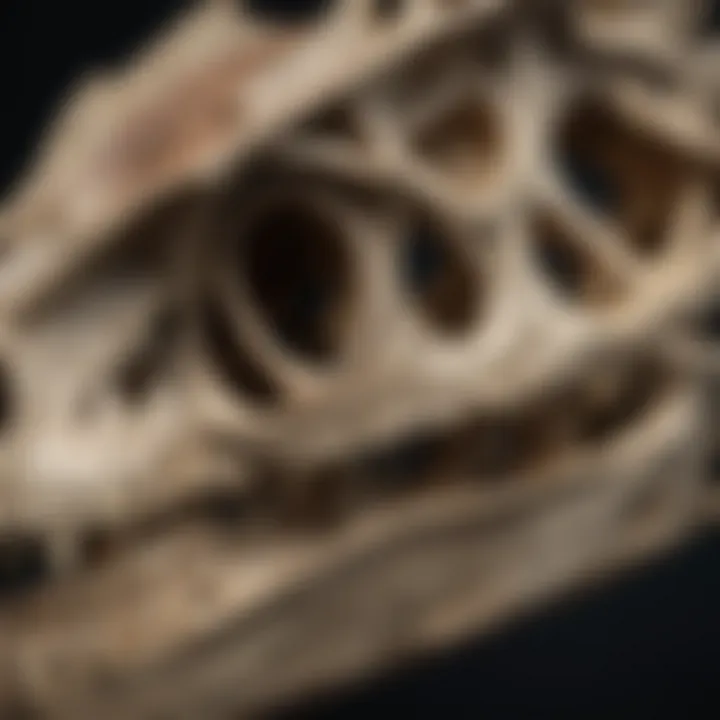
Intro
The Allosaurus skull replica stands as a significant representation of one of the most fascinating theropod dinosaurs. With its imposing structure and intricate details, it captures the attention of collectors and educators alike. Understanding the nature of these replicas is essential for both appreciation and study. In this exploration, we will delve into the historical context, construction aspects, and the role they play in both educational and collector communities. This knowledge not only enriches one’s collection but also enhances the awareness surrounding paleontology.
Featured Collectible of the Month
Overview
Each month, collectors and enthusiasts focus on a distinctive fossil replica, and this month highlights the Allosaurus skull. As a centerpiece of many displays, it showcases serious craftsmanship alongside scientific authenticity. The skull captures an understanding of Allosaurus morphology. This dinosaur roamed during the Late Jurassic period, roughly 155 to 150 million years ago. It possessed features such as a large nasal cavity and sharp, serrated teeth, providing insights into its predatory lifestyle.
Historical Significance
The Allosaurus has long piqued the interest of paleontologists. It is frequently described as one of the most well-known dinosaurs due to its relatively complete fossil record. Fossils first discovered in the late 19th century revealed much about its anatomy and behavior. The access to replicas has allowed not just for wider knowledge but also for fostering curiosity in learners. Each replica, crafted with care, represents a piece of history, enabling collectors to own a part of paleontological significance.
Identification Techniques
Visual Characteristics
When examining an Allosaurus skull replica, certain characteristics help in identification:
- The skull is elongated with prominent eye sockets.
- The teeth are large and serrated, designed for tearing flesh.
- Cranial bones may show distinct sutures, detailing the structure.
- It features a robust jawline, indicative of its carnivorous diet.
Collecting accurate replicas requires awareness of these features, as they reflect both the artistry of craftsmanship and the integrity of scientific representation.
Resources for Identification
Identifying high-quality Allosaurus skull replicas involves consulting various reliable sources. Recommended references include:
- Wikipedia
- Encyclopedia Britannica
- Online forums like Reddit and social media groups on Facebook can also offer support and shared experiences.
Engaging with these resources allows collectors to gain a deeper insight into both the scientific and artistic aspects of the Allosaurus skull replica, enhancing their understanding and appreciation.
Prelude to Allosaurus
The Allosaurus stands out in the study of dinosaurs for a variety of reasons. Understanding this formidable predator is key to deciphering the broader context of Jurassic ecosystems. This section will present an overview of the Allosaurus species, its significance within paleontological research, and how fossil records enrich our understanding of prehistoric life.
Overview of Allosaurus Species
Allosaurus is a genus of large theropod dinosaurs that roamed North America during the Late Jurassic period, approximately 155 to 150 million years ago. Distinctive for their large skulls and sharp teeth, Allosaurus were apex predators of their time, showcasing traits that indicate a highly effective hunting strategy. Their size varied, typically measuring around 30 feet in length and weighing roughly 2 tons.
From a biological standpoint, Allosaurus possessed a unique skeletal structure. Their limbs were built for both speed and agility, making them fearsome hunters. The posture reflected in their fossils shows strong forelimbs equipped with sharp claws, suggesting a capable grip on prey. Moreover, the adaptations hinted at a degree of social behavior, as evidence indicates possible group hunting habits.
Fossil Records and Historical Context
The fossil record for Allosaurus is rich, with numerous specimens discovered across North America. The first described species, Allosaurus fragilis, was identified in the late 19th century and has since become central to the narrative of dinosaur evolution. These fossils have been vital in piecing together the ecology of their habitats.
Fossils of Allosaurus have been located in various states, often accompanied by remnants of other dinosaurs. This cohabitation provides critical insight into the dynamics of dinosaur communities of the time. Each find contributes to the understanding of their dietary preferences—predominantly large prehistoric reptiles—thus affirming their role as top predators in their environment.
In summary, the study of Allosaurus extends beyond mere anatomy. Exploring their features and fossil context reveals essential information about life during the Jurassic epoch, not just for Allosaurus itself, but for a vast array of prehistoric life forms. This establishes the foundation for discussing the relevance and construction techniques of the Allosaurus skull replica.
Importance of the Allosaurus Skull
The Allosaurus skull plays a crucial role in understanding not only the species itself but also the broader context of dinosaur biology and behavior. Its unique anatomical structure offers insights into the adaptations that allowed Allosaurus to thrive during the Late Jurassic period. By studying these skull features, researchers can deduce important aspects of predation, feeding strategies, and ecological dynamics in prehistoric ecosystems.
The skull's distinctive attributes contribute to its significance. For instance, the large, robust jaw housing sharp teeth indicates a carnivorous nature. This detail is fundamental in reconstructing feeding habits and interactions within its environment. The skull's size and shape have implications for the Allosaurus's sensory capabilities, particularly its vision and hearing, which are vital for survival as a predator.
Anatomical Features and Function
The Allosaurus skull exhibits a range of anatomical features that are critical for its function as a predator. It is elongated, with a high degree of flexibility, ringing essential for its predatory lifestyle. The skull is characterized by a series of fenestrae, or openings, which reduce weight while maintaining structural integrity. This design helps in balancing robustness with agility.
The cranial crest behind the eyes might have played a role in display or species recognition. Such features are not merely ornamental; they are often linked to mating behaviors or social hierarchies. Additionally, the arrangement of the teeth suggests specific strategies for consuming prey, pointing to specialization in hunting techniques. Understanding these features allows paleontologists to hypothesize not just about Allosaurus's habits but also its interactions with contemporaneous species.
Behavioral Insights from Skull Studies
Skull studies of Allosaurus provide profound insights into the behavioral patterns of this dinosaur. Through careful analysis of the skull morphology, scientists can infer how Allosaurus hunted, interacted with other species, and adapted to its environment. For example, the size and placement of the eye sockets indicate a forward-facing vision, allowing for depth perception crucial for hunting.
Researchers also utilize finite element analysis to model skull strength and performance during biting. This scientific approach unveils the feeding mechanics of Allosaurus, shedding light on how it tackled prey. Insights from these studies can ultimately help reconstruct the ecosystem of the time.
"The Allosaurus skull is not just a fossil; it is a time capsule, containing information about life millions of years ago."
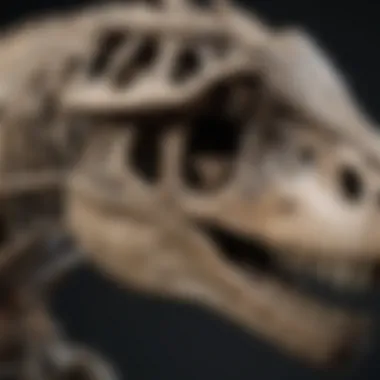
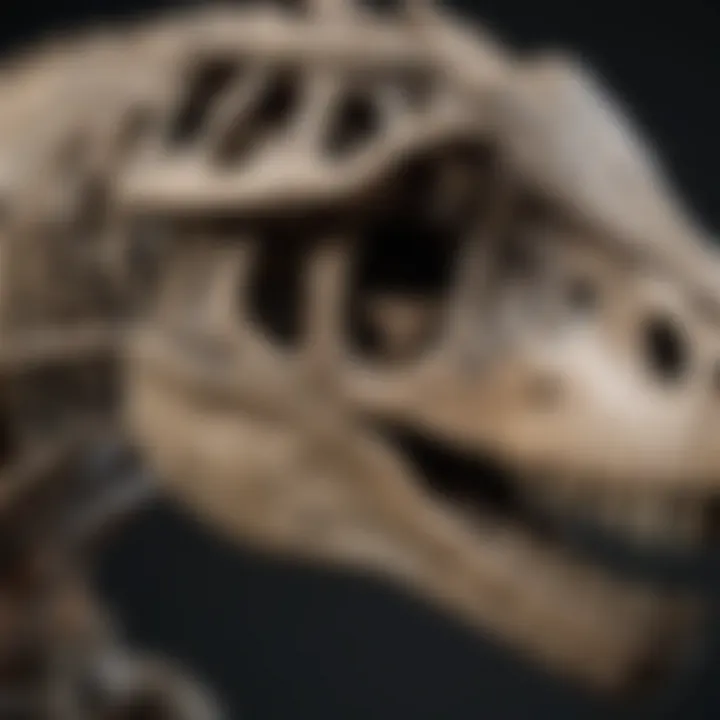
Creating the Allosaurus Skull Replica
Creating a replica of the Allosaurus skull serves multiple purpose. Firstly, it provides valuable insights into the ancient creature's anatomy, enhancing our understanding of its biology and evolution. Additionally, replicas are crucial for educational settings, where they can be used to demonstrate paleontological concepts to students. Lastly, they hold significant value for collectors, acting not just as decorative pieces but also as a means to connect with the rich history of dinosaurs.
Materials and Methods Used
To successfully create a replica of the Allosaurus skull, various materials are utilized. Commonly used materials include high-density resin, fiberglass, and sometimes even 3D printed components. Using high-density resin ensures durability while maintaining an accurate representation of the skull's features. Fiberglass composites provide additional strength and lightweight properties, which is beneficial for larger replicas.
The crafting process typically begins with obtaining high-quality scans of real Allosaurus skulls. These scans can be extracted from fossil records or obtained through digital imaging technologies. Once the data is gathered, it is used to create a detailed model that reflects the original anatomy. This model is then translated into physical form using different manufacturing methods.
Additionally, techniques such as mold-making are essential. Artisans often create detailed molds of the skull using silicone or plaster. These molds allow for the mass production of replicas while preserving intricate details such as bone structure and texture, which can enhance the realism of the final product.
Manufacturing Techniques
There are several manufacturing techniques employed in the creation of Allosaurus skull replicas. One popular method is 3D printing, which enables manufacturers to generate precise replicas. This technology allows creators to work from digital files of actual skulls. 3D printing reduces material waste and enhances the production speed, making it a preferred choice for many artists and companies.
Another common technique involves casting. After crafting a master model, a mold is created, and a liquid material is poured in, forming the replica. This approach allows for the replication of fine details, ensuring that texture and shape are replicated faithfully.
Furthermore, hand sculpting remains a viable option for creating unique replicas. Skilled artisans can use natural materials such as clay to model the skull before making a mold. This method is labor-intensive but allows for customization and artistic expression in the final product.
"The combination of modern technology with traditional skills results in accurate and captivating skull replicas."
In summary, the creation of an Allosaurus skull replica incorporates a variety of materials and techniques that contribute to the quality and detail of the final product. Collectors and educators alike benefit from understanding this process, as it provides context around the significance of these remarkable artifacts.
Acquisition of Allosaurus Skull Replicas
Acquiring an Allosaurus skull replica holds significant importance for collectors, educators, and researchers alike. It is essential not just for display, but also for gaining a deeper understanding of paleontological scenarios and enhancing education in historical sciences. These replicas allow individuals to own a piece of ancient history with added context, enabling conversations around evolution, behavior, and anatomy of dinosaurs. The experience extends beyond mere ownership; it enhances appreciation for the intricacies of scientific study and the historical significance of the Allosaurus as a dinosaur species.
Where to Source Replicas
When looking to acquire an Allosaurus skull replica, several avenues can be explored.
- Specialized Retailers: Many dedicated fossil or replica shops sell high-quality reproductions. These retailers often feature knowledgeable staff who can provide insights and guidance on the best options available.
- Online Marketplaces: Platforms such as eBay or Fossilicious offer numerous listings for Allosaurus skull replicas. It's essential to read reviews and check seller ratings to ensure quality and reliability.
- Paleontological Exhibitions: Visiting fossil shows or exhibitions can provide direct access to sellers specializing in dinosaur replicas. This setting allows potential buyers to inspect the replicas firsthand.
- Museums: Some museums have gift shops where visitors can purchase replicas of fossils on display. This route supports educational institutions while offering products based on scientifically accurate models.
- Custom Orders: For those looking for tailored options, certain artisans and manufacturers may accept custom orders, creating replicas that fit specific requirements or preferences.
Evaluating Quality in Replicas
Determining the quality of an Allosaurus skull replica is crucial before making a purchase. Several factors should be taken into account:
- Material: High-quality replicas are typically made from durable materials, such as resin or polycarbonate. It's essential to assess the type of material used, as this affects both appearance and longevity.
- Detail and Accuracy: The degree of detail in the replica matters. Examining how well the features replicate a real Allosaurus skull can provide insights into its craftsmanship. Authenticity in proportions and textures is important.
- Finish: A well-finished replica usually indicates higher quality. Look for a smooth surface and a realistic appearance without visible seams or imperfections.
- Weight: High-quality replicas tend to have a certain heft due to better materials. If a replica feels too light, it may indicate inferior production.
- Reviews and Feedback: Checking customer reviews and product ratings can help gauge the experience of previous buyers. Positive feedback is often an indicator of quality.
In selecting an Allosaurus skull replica, it's essential to weigh these factors carefully. Owning a high-quality replica enhances one’s collection while also contributing to a better understanding of paleontology.
"A well-crafted replica not only serves as a decorative piece but also as an educational tool that can spark discussions and enhance learning experiences."
By focusing on reputable sources and understanding what constitutes quality, collectors can confidently expand their collections with accurate and meaningful representations of the Allosaurus.
Displaying the Allosaurus Skull Replica
Displaying an Allosaurus skull replica is not just about showcasing a fascinating piece of paleontological history; it's also a matter of presentation that enhances its educational value and aesthetic appeal. A well-displayed replica can evoke interest and curiosity while communicating important information about the ancient creature it represents. Collectors and educators alike must consider various factors that contribute to an effective presentation. This section will delve into the optimal display techniques and the integration of educational components, ensuring that the skull serves both a decorative and informative purpose.
Optimal Display Techniques
To properly display an Allosaurus skull replica, the first step is to choose an appropriate location. It's essential to place it in a well-lit area, preferably with natural light, as this can highlight its intricate details. However, direct sunlight should be avoided to prevent potential fading or damage. The display height is also critical; it should be positioned at eye level to allow viewers to engage with it comfortably.
Using custom mounts can enhance the overall display. These mounts should be sturdy enough to support the weight of the skull while minimizing visible hardware. A common choice is acrylic stand which offers transparency, creating the illusion that the skull is floating, thus allowing viewers to appreciate it from all angles. It's also important to maintain a clean background that contrasts with the skull itself to make it stand out.
Adjusting the angle of the display can further enhance visibility. Slightly tilting the skull can reveal unique features that may be missed when viewed straight on. Incorporating lighting techniques, such as spotlighting or soft ambient lighting, can also bring out textures and colors, adding depth to the visual presentation.
Incorporating Educational Elements
Integrating educational components into the display of an Allosaurus skull replica greatly increases its impact. Informative placards or digital screens can provide context about the Allosaurus species, including its habitat, diet, and place in the evolutionary timeline. This information should be presented in a clear and concise manner, catering to a variety of audiences, from children to adult collectors.
Hands-on interactive elements may also be beneficial. For example, offering a tactile element, such as a similar texture replica of bones or fossils, can help to enhance the educational experience. Additionally, QR codes can be placed nearby, linking to online resources or videos that provide further details on the Allosaurus and its significance in paleontology. This not only makes the display dynamic but also encourages viewers to engage and explore the subject matter more deeply.
"A well-thought-out display does more than showcase a replica—it educates and inspires curiosity about the past."
Choosing to display an Allosaurus skull replica thoughtfully can transform it into a powerful educational tool. It facilitates a deeper understanding of prehistoric life while providing a striking visual centerpiece that sparks conversation among collectors and onlookers. By paying attention to the aesthetic and informative elements, collectors can ensure their displays are both beautiful and enlightening.
Caring for Your Allosaurus Skull Replica
Caring for an Allosaurus skull replica is more than just a responsibility; it is an integral part of ensuring the longevity and integrity of this remarkable artifact. As a representation of paleontological history, proper maintenance and care allow collectors and educators alike to fully appreciate the intricacies of paleobiology. Replicas can fade, crack, or degrade over time if not appropriately cared for. Therefore, understanding effective cleaning strategies and optimal storage conditions is essential for preserving these valuable items.
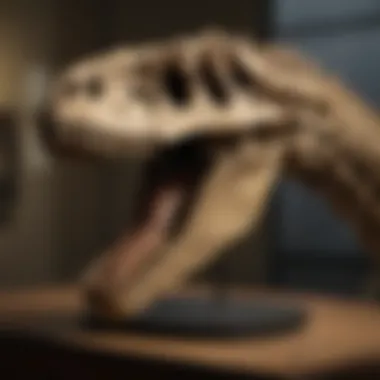
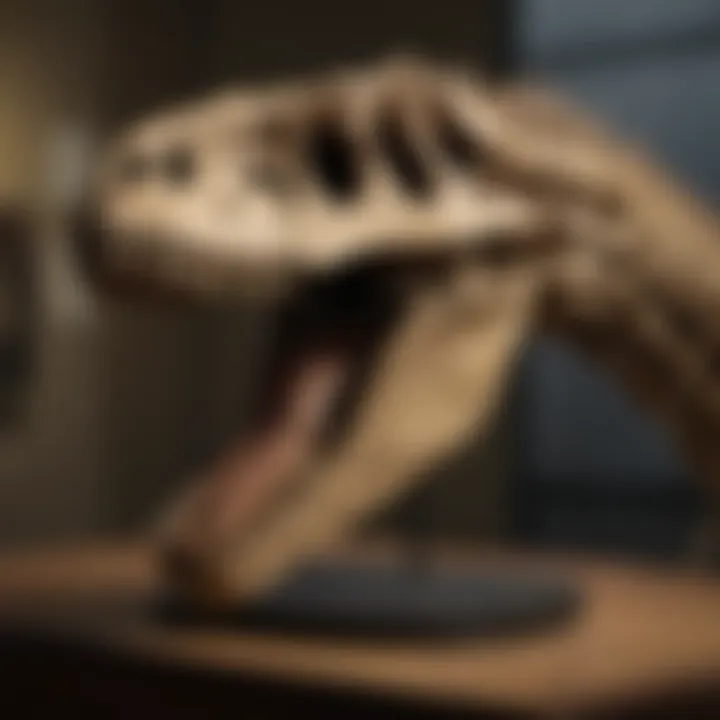
Cleaning and Maintenance Strategies
When it comes to cleaning the Allosaurus skull replica, the techniques employed can significantly affect its appearance and durability. Regular cleaning not only enhances the aesthetic value but also prevents dust and grime buildup which can obscure detail.
- Use Soft Brushes: A soft brush can efficiently remove dust particles without scratching the surface. Avoid using anything abrasive that could cause irreversible damage.
- Mild Soap Solutions: For deeper cleaning, a mixture of mild soap and water can be applied with a soft cloth. Ensure that the cloth is damp, not wet, to avoid moisture absorption which can harm the material.
- Avoid Chemical Cleaners: Harsh chemicals can harm the finish of the replica, leading to discoloration or damage. Stick to natural cleaning solutions whenever possible.
"Proper cleaning extends the life of your Allosaurus skull replica, allowing it to be appreciated for years to come."
Also, it is advisable to inspect the replica regularly for any signs of wear or damage. Any cracks or chips should be noted and treated promptly to prevent further deterioration. It's also helpful to consult with professionals if major repairs are needed. The investment in time for maintenance ultimately pays off in retaining the value and integrity of the replica.
Storage Considerations
Proper storage is critical for maintaining the condition of an Allosaurus skull replica. Factors like temperature, humidity, and positioning can influence the state of these replicas over time.
- Stable Environment: Store the skull in a cool, dry place. Fluctuations in temperature and humidity can lead to warping or cracking.
- Display Cases: If possible, display the replica in a showcase to minimize dust exposure and prevent accidental damage. Make sure the case allows for ventilation to avoid trapped moisture.
- Avoid Direct Sunlight: Prolonged exposure to UV rays can fade colors and degrade materials. Position the replica away from windows or bright lights.
By adopting these cleaning and storage practices, collectors can ensure that their Allosaurus skull replica remains a magnificent focal point of their collection, serving as a constant reminder of the rich tapestry of our planet's prehistoric life. Finding the right balance in care not only enriches personal collections but also plays a pivotal role in the educational engagement it provides.
The Market for Allosaurus Skull Replicas
The market for Allosaurus skull replicas is a dynamic and fascinating aspect of paleontological collectibles. It encompasses various elements including current pricing trends and the investment value of these replicas. Understanding this market is vital for collectors who wish to make informed decisions regarding their purchases or sales. Moreover, it provides insights into the broader implications of fossil replications in terms of cultural significance and educational value.
Current Pricing Trends
Pricing for Allosaurus skull replicas can vary significantly based on several factors. Some of these include the quality of the replica, the materials used, and the level of detail in the craftsmanship. Generally, prices can range from a few hundred to several thousand dollars. High-quality replicas made with durable materials can command higher prices due to their realism and attention to detail. Some key points to consider in pricing patterns include:
- Market Demand: As interest in paleontology grows, the demand for authentic-looking replicas increases. This drives prices upward.
- Material Influence: Replicas made from resin or high-quality plastics usually cost less than those crafted from more expensive materials like limestone or fiberglass.
- Provenance and Certification: Authentic replicas from reputable manufacturers tend to be more valuable. Collectors often pay a premium for items that come with a certificate of authenticity.
Keeping an eye on market trends can help collectors and potential buyers gauge when is the best time to purchase. Online platforms and specialty stores can help in assessing the current market landscape.
Investment Value of Replicas
Allosaurus skull replicas can serve not only as impressive displays but also as investment opportunities. The value of these items can appreciate based on factors such as rarity, condition, and market demand. Investing in replicas has its pros and cons. Here are several considerations:
- Potential for Appreciation: If there is a rise in interest in paleontology or if a particular replica gains notoriety, its value can increase. Rare or limited-edition replicas can appreciate substantially over time.
- Educational Role: Replicas used in educational settings may gain credibility, and their market value can reflect that. Schools and institutions often seek quality replicas for teaching, which can drive demand up.
- Market Risks: Like any collectible, there are risks involved. Not every replica will appreciate, and market fluctuations can lead to unforeseen changes in value.
Ultimately, the investment potential in Allosaurus skull replicas is influenced by market dynamics and individual decisions of collectors. By understanding these elements, collectors can navigate the market more effectively, making informed decisions that align with their interests and investment goals.
"The value of a replica is no longer just in its aesthetic appeal but also in its ability to educate and enhance understanding of paleontological history."
Role in Education and Research
The significance of the Allosaurus skull replica extends well beyond mere fascination. These replicas serve as critical tools in both education and research. In academic environments, where the intricacies of paleontology are taught, a tangible representation of the Allosaurus skull enhances understanding and reinforces learning objectives. Furthermore, replicas bridge gaps between complex scientific concepts and accessible education for individuals with varied backgrounds.
Using Replicas in Teaching
In classrooms, the use of Allosaurus skull replicas brings several advantages. First, using a physical model provides students with a multi-sensory learning experience. This experience often leads to better retention of information, as students can physically observe and sometimes handle the replica. Notably, this interaction can spark interest in scientific inquiry.
Educational institutions can utilize these replicas to teach various topics:
- Anatomical structures: Students learn about different skull features such as the orbits, teeth, and jaw mechanics.
- Evolutionary biology: Replicas provide a basis for discussions on evolution and the adaptation of species over time.
- Paleobiology: This includes examining dietary habits and environmental factors that influenced the Allosaurus.
Additionally, incorporating replicas into lesson plans encourages critical thinking. Students may engage in analyses or comparisons with other dinosaur species. This process promotes collaborative learning and creative thinking, essential skills in any academic discipline.
Research Applications of Skull Replicas
Beyond the classroom, the Allosaurus skull replica plays an integral role in research. Scientists and scholars often employ replicas to explore hypotheses regarding the creature's behavior, diet, and environment. Replications of fossilized skulls allow researchers to conduct studies without risking the integrity of original fossils. Some notable research applications include:
- Biomechanical analyses: Researchers can examine how skull shape influences feeding behaviors and mechanics.
- Paleoecological studies: Understanding the ecological niche of the Allosaurus can be achieved through comparative studies with modern predators.
- Formal education and outreach: Researchers utilize replicas for public exhibitions, effectively communicating scientific ideas to a broader audience.
This versatile application underscores how replicas significantly contribute to our overall understanding of paleontological concepts. As research methods evolve, the role of Allosaurus skull replicas will remain vital, serving as a bridge between inquiry, education, and public engagement.
The Allosaurus skull replica not only enhances education but also serves essential research needs, allowing deeper understanding of this magnificent dinosaur.
Ethical Considerations in Collection
The collection of Allosaurus skull replicas is a subject intertwined with various ethical considerations. As the interest in paleontological artifacts continues to grow, it is essential to address how these items are sourced and displayed. Understanding these considerations helps collectors maintain integrity and respect within the fossil collecting community.
Legality of Replicas
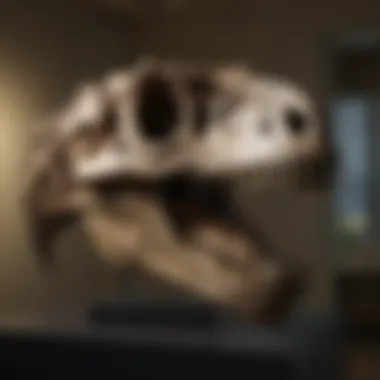
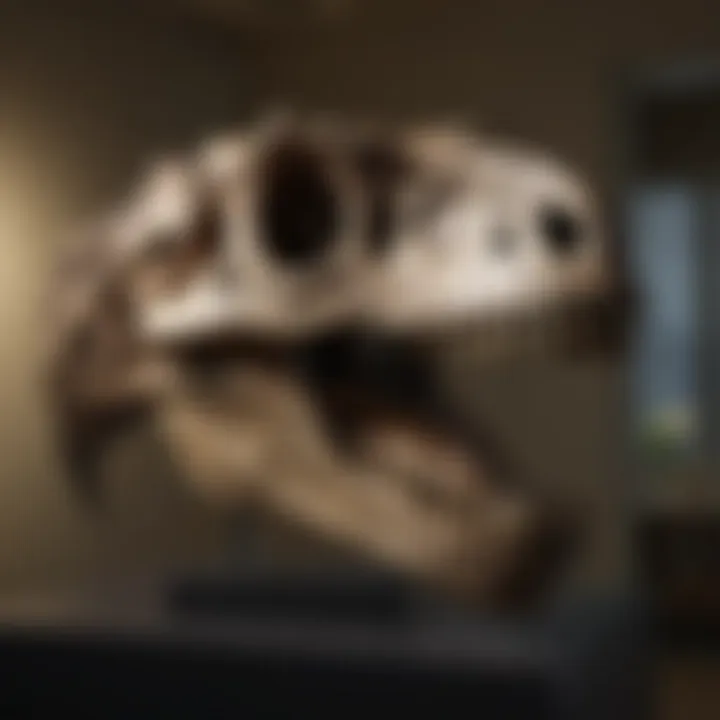
The legal framework surrounding the acquisition and ownership of fossil replicas must be well understood. While owning a replica may seem straightforward, the legality can vary significantly based on location. Most regions have regulations that govern the collection of fossils, including replicas. It is paramount for collectors to ensure that the replicas they acquire are produced and sold in compliance with local laws and international treaties. Some countries classify fossils as state property, restricting collection or sales without official permits. Therefore, collectors should research the legal status of fossils in their area to avoid unwittingly engaging in illegal activities.
It is advisable to purchase replicas from reputable dealers who can provide documentation verifying compliance with relevant laws. The existence of such documentation is not merely a formality; it reinforces the authenticity of the replica while ensuring that it does not contribute to illicit fossil trade.
Sourcing Responsibly
Responsibility in sourcing replicas extends beyond mere legality; it includes an ethical obligation to support sustainable practices. Collectors should prioritize acquiring replicas from sources that uphold ethical standards in production. This means seeking vendors who practice transparency in their methods and avoid exploitation of fossil materials. Some manufacturers may utilize advanced technologies such as 3D printing to create replicas while ensuring they do not disturb natural habitats or involve real fossil exploitation.
Moreover, supporting ethical sourcing can also involve contributing to conservation efforts. Many organizations focus on paleontological preservation, and some of these offer replicas as part of their educational initiatives. By purchasing from such organizations, collectors contribute to the ongoing efforts to protect true fossils and educate the public about paleontology.
In summary, when engaging in the field of fossil collection, especially concerning Allosaurus skull replicas, it is essential to consider the legality and responsible sourcing. By approaching the collection with integrity and respect, collectors not only enhance their own knowledge and enjoyment but also contribute positively to the wider community.
Interacting with the Fossil Collecting Community
Engaging with the fossil collecting community is crucial for those interested in Allosaurus skull replicas. This interaction facilitates learning, networking, and sharing knowledge. Fossil collecting is not just about owning artifacts; it is about being part of a vibrant and passionate community that appreciates the intricacies of paleontology.
Joining Collector Groups and Forums
One of the initial steps to becoming active in this community is joining collector groups and forums. Online platforms, such as Reddit and Facebook, host various groups where enthusiasts and experts share invaluable insights. These forums can offer a wealth of information regarding Allosaurus skull replicas. Members typically discuss their experiences, tips for acquiring replicas, and specific features to look for in quality pieces.
Participating in these discussions can broaden one's understanding of the subject. Individuals can learn about lesser-known resources for obtaining replicas. Moreover, these groups often provide access to exclusive events, sales, or trade opportunities that may not be available elsewhere.
In addition to online engagement, local fossil clubs or organizations can present further benefits. These clubs often organize field trips, where members can search for fossils together. This collaborative approach enhances the overall experience, allowing participants to deepen their appreciation of paleontological science.
Participating in Exhibitions and Shows
Another vital aspect of interacting with the fossil collecting community is attending exhibitions and shows. These events not only display impressive collections but also serve as platforms for networking among collectors, researchers, and enthusiasts. Exhibitions often feature guest speakers who are experts in the field of paleontology, providing insights into the latest research and discoveries.
Participation in these events allows collectors to meet face-to-face. One can exchange stories, discuss techniques, and share advice on the best practices for caring and displaying skull replicas. Additionally, exhibitions often have vendors offering replicas for sale, giving attendees a chance to purchase unique pieces that may not be available online.
Attending shows can also open up opportunities for collaborations. Collectors can connect with paleontologists, educators, and even museum curators, which can lead to shared projects or educational initiatives. Being part of this community encourages the exchange of ideas, enhancing not only individual collections but also contributing to the collective understanding of fossil specimens.
Engaging with the fossil collecting community helps cultivate a passion for paleontology, enriching personal collections with knowledge and connections.
Future Trends in Skull Replicas
The world of dinosaur skull replicas, particularly the Allosaurus, is evolving rapidly. This section draws attention to the significance of understanding these trends, especially for collectors, educators, and those interested in paleontological studies. Key elements in production, marketing strategies, and ethical considerations will shape the future of these replicas. Being aware of these trends helps buyers make informed decisions and enhances engagement in collecting.
Technological Advancements in Production
New technologies are impacting the way fossil replicas are made. Traditional methods often required substantial manual labor and time. Now, 3D printing is creating opportunities for faster production. This technology allows for a high level of detail, capturing the intricate features of the Allosaurus skull. More accurate replicas are emerging due to higher fidelity in modeling software and enhanced materials. Techniques such as laser scanning help to ensure replicas match the original fossils closely. Collectors can appreciate a replica that conveys authenticity without compromising on craft.
Additionally, advancements in materials science are improving the durability and realism of replicas. Companies are using specialized resins and composite materials that make the skulls look more lifelike. Some replicas even incorporate UV-resistant coatings, allowing them to retain their color and structure when displayed in sunlight. These developments not only satisfy aesthetic preferences but also extend the lifespan of the products.
Market Predictions
The market for Allosaurus skull replicas is expected to undergo significant shifts in the coming years. Increased interest in personalized collections is fostering demand. Collectors are looking for unique pieces that tell their own stories. Moreover, as educational institutions recognize the value of replicas in teaching, the market for academic-grade replicas is likely to expand. This makes it essential for producers to align their marketing strategies with educational trends.
Pricing is also a big concern. Replicas that start at reasonable rates may see appreciation as they become more sought after. With technological advancements, the cost of production may decrease, but the demand for high-quality replicas will keep prices stable or increase. The overall trend shows that consumers are willing to invest more in replicas that offer authentic experiences.
"The future of Allosaurus skull replicas hinges on the intersection of technology and market demand, making each replica not just a product but a valuable learning tool."
Educators, collectors, and those engaged in research are encouraged to stay informed about these trends. Understanding market dynamics can enhance their collection experiences and foster a deeper connection with the rich history of paleontology.
Epilogue
The conclusion of this article serves a critical role in synthesizing the multiple elements covered regarding the Allosaurus skull replica. As the final section, it ties together various threads, reinforcing the distinct significance of these replicas in paleontological study, education, and personal collections. By reflecting on the historical context, construction methods, ethical considerations, and their impact on both collectors and researchers, the conclusion highlights the multifaceted importance of the Allosaurus skull replica.
One benefit of understanding these key points is that it allows collectors to appreciate the value of their replicas beyond mere aesthetics. The knowledge gained can deepen their engagement with the objects in their collections. Additionally, acknowledging the ethical dimensions of sourcing and collecting fosters a sense of responsibility within the community. As individuals advance in their collecting journey, they benefit from informed decisions that affect both personal satisfaction and the broader implications for paleontological integrity.
"Replicas provide an accessible way to connect with history, foster research, and contribute to educational initiatives."
This culminates in a call for future exploration, emphasizing the avenue for continued learning within the realm of paleontology and fossil collecting. As information evolves, so too will the appreciation and understanding of these ancient creatures and their representations in modern society.
Summary of Key Points
In this article, we discussed several integral aspects surrounding the Allosaurus skull replica. Key takeaways include:
- Historical Significance: The Allosaurus is a pivotal figure in dinosaur studies, and replicas help bridge the gap between ancient biology and contemporary understanding.
- Construction Techniques: Various methods contribute to creating accurate and durable replicas, ensuring they serve educational and aesthetic purposes effectively.
- Educational Engagement: These replicas play an indispensable role in teaching environments, offering hands-on experiences that enhance learning.
- Market Trends: Understanding current pricing and investment potential provides valuable insights for collectors.
- Ethical Responsibility: It is essential to source replicas legally and responsibly, maintaining the integrity of collections.
Encouraging Further Exploration
As we conclude, it is crucial to encourage readers to delve deeper into the subject of Allosaurus skull replicas. Engaging with this topic can uncover more about the intricate processes involved in paleontological research. Investigating local collector communities, joining forums, or attending exhibitions can further enhance one's knowledge and appreciation.
Books and Resources: Consider exploring literature focused on paleontology and fossil collecting. Websites like Wikipedia and Britannica offer a wealth of information. Engaging with social platforms such as Reddit can connect you to like-minded individuals who share a passion for dinosaurs and fossils.
By pursuing this knowledge, collectors and enthusiasts not only enrich their own understanding but also contribute to the broader conversation on paleontological significance.



